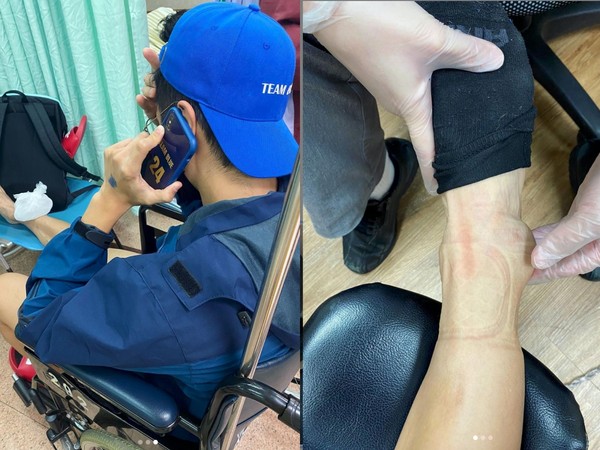Hudson Yards: two words on the lips of Manhattan residents. The pharaonic project initiated in 2012 by the city and state of New York – the largest in the history of the United States financed by the private sector – begins to take serious shape, with the opening of the first building in 2016 (10 Hudson Yards) and the rapid growth of his “brothers” around him. In all, six new buildings will have emerged in 2024, spread over 11 hectares west of Manhattan, for an investment of 20 billion dollars, with the architectural firm Kohn Pedersen Fox, one of the most powerful in the world. world (Tour First in Paris, ICC in Hong Kong), at the helm.
30 Hudson Yards, one of the 6 buildings of the eponymous project. Inauguration scheduled for 2019. Julien Chassagne
If it is above all to create a new nerve center in Manhattan, its borough the most crowded, that New York has launched the great maneuvers of Hudson Yard, it also wants to make this new far west a symbol of the city. He then needs a iconic landmark just like the Charging Bull (and the bronze girl who recently faces him) from Wall Street or that theAtlas which sits in front of Rockefeller Center. A challenge that the British studio Heatherwick decided to accept, by designing the Vessel. No particular function for this copper monster under construction, which is scheduled for delivery next year. It will have to impress, attract the sympathy of the inhabitants and intrigue tourists until it becomes an essential meeting point. If you have thought of the Eiffel Tower, then you are as ambitious as its architect… who dared this comparison when the project was unveiled in September 2016 (which we were talking about here).

The Vessel under construction, the future Eiffel Tower in New York? Julien Chassagne
Big projects which, inevitably, call for others. It’s very simple, at the exit of the metro we slalom between the sites. Among the most anticipated, the 3 Hudson Boulevard on the 34e street by Fxfowle Architects, whose inauguration is scheduled for 2019 and which will place its imposing 315-meter-high footprint on the skyline of Manhattan. The New York city skyline will also have to get used to another equally prestigious inhabitant: The Spiral, green and glass, designed by Bjarke Ingels, which will also exceed three hundred meters. An effervescence and a nest of “archistars” which attract firms quick to change address (L’Oréal, CNN, HBO, Time Warner in particular). Large groups that come to settle at the edge of the High-Line, when Turtle Bay, Midtown and the south of Manhattan then monopolized all the business centers of New York. West Manhattan will have soon – has it already? – his say.
New York Green Line
Once past the Hudson Yards construction sites, behind a fence, almost a back entrance, access to the last portion of the High Line, inaugurated this year. Spread between 2009 and 2017, the gradual opening of the New York Greenway is coming to an end. Initiated by the inhabitants of the district and approved by a Michael Bloomberg, recently elected in 2004, the rehabilitation of this old railway line is, without question, at the origin of the transformation of the districts it crosses and connects. Hudson Yards to the north, the regained prestige of West Chelsea then almost in decline and the transformation of the Meatpacking District into a neighborhood trendy, South. Throughout the route, signs from real estate agencies, buildings signed by renowned architects like Zaha Hadid and works of art, placed here and there. A walk that has contributed to the realization of dozens of real estate projects, of which more than 30 are still under study or under construction. Impressive.

More than 5,000,000 visitors use the High Line each year, in an area that was not among the most touristic. Around dozens of real estate projects flourish. Julien Chassagne
The turmoil in western Manhattan isn’t just about a battle of skylines with the rest of the borough. The Meatpacking district – yes, as in Copenhagen – has a similar fate to its Scandinavian namesake. An old district to be avoided, it has been trendy since the transition to the year 2000. Former slaughterhouses converted into trendy boutiques and concept stores, such as Artist and Fleas, bazar bobo-chic brooklynien who has chosen the neighborhood to set up his Manhattan boutique, vegan and locavores restaurants in spades – here, no Wendy’s or Taco Bell – and chic boutique hotels like the Maritime. Climax of this gentrification (which is not finished, we still zigzag between excavators and concrete mixers), the opening in 2015 of the Whitney Museum of American Art. Once again, it is a “starchitect” in action, the Italian Renzo Piano.

Le Meatpacking district, petit Brooklyn chic. Julien Chassagne
Serial gentrification, large-scale real estate projects, urban and cultural rehabilitation, western Manhattan earns its place on the Manhattan map by the force of the wrist. But these three neighborhoods will not become the new Williamsburg for all that, the fault of the notable differences between the prices of rents and real estate. Where inner-city Brooklyn earns an average of $ 32,000 per year per household, Chelsea’s earn 98,000 $ and those of Meatpacking 214,000 $. But they offer a new face to Manhattan, transforming the landscape, then attracting a population younger than that of Midtown (36 years against 50 years of average age). A Brooklyn that trades beer for cosmo, in short.
–


